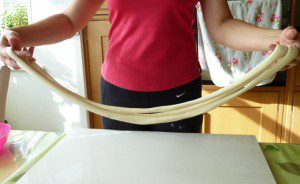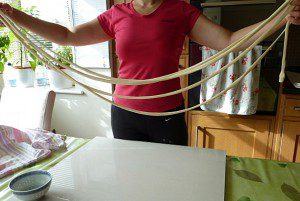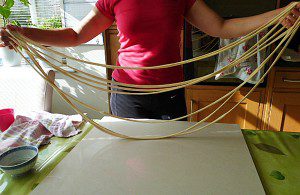Recipe for Lamian Noodles in Uyghur Lamb Stew. Lamian are handmade, hand-pulled Chinese noodles. Fun to try your hand at it!
Estimated reading time: 4 minutes
Table of contents

Lamian is a type of Chinese noodles, hand pulled and made with only flour, water and salt, you don’t have to go very far in China to find restaurants or outlets specialising in lamian and it seems to me that these days, everywhere you look online, there’s a video of someone pulling some noodles! They do vary in thickness, from slightly wide and flat to extremely fine, so fine that it’s hard to believe they are hand made!
La = pull, Mian = noodles
I first came across lamian some years ago in China and have been fortunate enough to have eaten different variations, including my favourite, made by the Uyghurs. The noodles themselves are fairly similar but it’s what they’re served with that makes the difference, I remember being completely bowled over by the combination of Chinese noodles and lamb stew – totally unexpected!
The Uyghurs are an ethnic group found in Xinjiang, northwest China, an area officially recognised as being autonomous, much like Tibet. The Uyghurs identify themselves culturally and ethnically with other central Asian cultures, for one thing, unlike the Chinese in China, the Uyghurs are Muslims. Their cuisine is therefore a delightful mix of what is to their East (China), West (India, Pakistan, etc) and to some extent, the North (Russia).

Born and bred Singaporean, noodles are second nature to me, we eat them for breakfast, lunch, dinner, as a snack, or for no reason at all! But this, fresh, handmade noodles served with a light but delicious, lamb and vegetable stew was an experience that haunted me, I had nothing else for days after!
The Uyghur lady was so kind, actually, probably felt sorry for me, whatever her reason, she sat me down and showed me how she made the noodles and more importantly, the stew. That lesson has stayed with me all these years and while the stew is something I’ve made countless of times (marvellous with baguettes!), the fresh lamian noodles is a fairly new endeavour. I love making fresh lamian noodles at the weekend when I have the time and inclination!

Making Lamian at Home
There’s so much written out there about the dough for lamian – high gluten, low gluten, cold water, warm water, lye water, kansui, sodium bicarbonate – it boggles the mind! All I can say is this, if you are interested in trying your hand at lamian, the only thing that’s going to help is time & experience! I’ve used high gluten flour, regular plain flour and yesterday, “00” flour for the first time. Guess what? They all stretched fine for me. However, I must emphasise that at the time of writing this, autumn 2013, I am only a novice, and my “pull” isn’t as long as lamian masters, which some flours might not stand up to.
One of the key things I find that helps the stretch and prevents breakage, is resting, twice before the pull & I like to let the stretched noodles rest about 2-3 minutes if I find that they are resisting the stretch. The Uyghur method I learnt uses vegetable oil to coat and after the initial stretch, you coil the dough on a plate, rest again, then start the acrobatics. While I do prefer the oil to the flour method, I don’t always coil my dough. The dough also wants to be wetter than usual, something that took me by surprise, this also aids the stretch. Talk is cheap, right, so here’s the recipe, same ratio for all types of flour I’ve used. Start with regular old plain flour, as a base.
The pictures here are from my 3rd try at making lamian. I’m fairly happy with their thickness, when I make them these days, they’re marginally thinner.
You can always enjoy this delicious lamb stew with any type of shop bought noodles. Rice noodles go very well in this, as does rice itself! And freshly baked bread!
Shall we get our aprons on?
If you like the recipe, don’t forget to leave me a comment and that all important, 5-star rating! Thank you!
And if you make the recipe, share it on any platform and tag me @azlinbloor, and hashtag it #linsfood
Lin xx

Lamian in Uyghur Lamb Stew (Hand pulled Chinese noodles in lamb stew)
Ingredients
Lamian dough
- 540 g all purpose flour (see above)
- 350 ml warm water
- 1 Tbsp salt dissolved in water above
- large saucepan of simmering water on the stove
Uyghur Lamb and Vegetable Stew (for Lamian)
- 500 g lamb leg is my favourite for this
- 2 Tbsp vegetable oil
- 2 medium onions chopped
- 8 cloves garlic chopped
- 5 cm ginger chopped
- 2 star anise “petals”
- 2 tsp salt
- 2 handfuls green beans sliced
- 2 handfuls white cabbage or Chinese cabbage sliced
- 1 red capsicum sliced, not too thinly
- 1 yellow capsicum sliced, not too thinly
- 2 tomatoes quartered
- ¼ tsp ground white pepper
- 1 litre lamb or beef stock
Garnish
- 2 handfuls fresh coriander leaves (cilantro chopped
- 2 spring onions (scallions) sliced
Instructions
The Noodles
- Use a table top mixer with dough attachment if you prefer it to hand kneading.
- Place the flour & salt water in a large bowl and bring it all together with your hands or using the mixture until it comes away clean.
- Knead for about 15 minutes if by hand, 3 minutes on medium speed in mixer.
- Place dough in a lightly oiled bowl, cover with cling film and leave to rest for 30 minutes.
- After 30 minutes, lightly oil your work surface and roll the dough out slightly with the palm of your hands. Start from the middle and work your way out, until you have a long, thick sausage about half a metre long, see pic 2. Leave it on the surface, cover with a damp tea towel & rest for 10 minutes.
- Grabbing each end of your dough, hit/bounce the middle bit on your surface a few times, without pulling on the dough. It's the weight & momentum that will pull and stretch your noodles, not your hands. Tip: don't pinch too hard at the ends, as light a touch as you can.
- When you can't stretch your arms further, fold the dough over in half (double over), hold each end & repeat the process. Keep doing this, i.e., fold and bounce, for as long as you think you can. If the odd strand breaks, don't worry about it, keep going if you think you can.
- When you can't or don't want to stretch any longer, place the noodles as they are in your hands, straight into the bowl of simmering water, increase the heat to bring the water back to boil, then simmer to cook your noodles for 4-5 minutes. The thicker your noodles, the longer the cooking time.
Lamb Stew (do this while the noodles are resting)
- Heat oil in a heavy based saucepan over medium heat and sauté the onions for about 3 minutes.
- Add garlic, ginger & star anise and sauté for 1 minute.
- Add lamb, turn heat up and brown for about 5 minutes, stirring constantly.
- Add the salt, give a good stir and follow with the stock. Bring to boil, then simmer, covered, for 1 hour.
- Add everything but the herbs for garnish and cook for another 30 – 45 minutes until the meat is cooked and very tender.
- Check and adjust seasoning if necessary.
To serve
- Divide the noodles equally into 4 bowls and top with the stew, scatter the herbs over and serve immediately.
- I like to have a little bowl of pickled chillies or chilli sauce on the side for people to help themselves to, as this dish has no heat at all.







Hi Azlin,
Thank you for sharing your recipe! I’ve been curious about pulled noodle, and attempted to make it several times but not luck so far. So I’m really excited at trying your recipe! Before that, I have couple questions. What’s the temp of warm water? Lukewarm? Need to be boiled?
And I’ve watched tons of videos, and they work on the dough by stretching and twisting it several times. But your method doesn’t request it. If I overwork the dough , it is harder to pull the noodle?
Hi Grein, it is a lot of fun making these noodles, isn’t it?
Warm water – lukewarm, doesn’t need to be boiled.
I’ve aways wanted to experiment with hot water here, changing the behaviour of the dough, but just haven’t got around to it in all these years!
One of the tricks in getting this right is getting the balance right. You are right in that if you work the dough too much, the gluten gets all excited, and it will resist attempts to stretch it, which is why I suggest resting the dough, each time you see it shrinking back, after being pulled.
The stretch in making lamian comes more from the weight of the noodles than us pulling the dough apart (step 6 explains this). I do stretch them, but I do it by allowing the noodles to “hang” from their own weight and drop with gravity.
Thank you Azlin! I’ll try it tomorrow and let you know how it works!
Hi azlin , can i use wheat flour for this receipe
Yes, all purpose flour will be wheat flour, and white. I’ve never used wholemeal (brown) wheat flour for this, in case that’s what you meant.
I used glutinous rice flour for this recipe which I thought should have worked but it was chalky and more like clay. Didnt stretch even slightly
Hi Jake, for dough to stretch, it needs gluten, and rice flour is gluten free with a very high starch content, as you know. That’s why rice noodles tend to have a different bite to them.
The science: as soon as the wheat flour comes into contact with liquid, the individual gluten proteins start unravelling and hooking on to each other, creating a strong bond. This will move on to an elaborate gluten string network, allowing the dough to stretch without breaking.
I hope that helps.
Thanks for sharing, this looks great, I’m going to try this tomorrow! I’ve never made them but a friend gave me some penghui (蓬灰). I have no idea what to do with that so I was just curious if you had experimented with that yet. 😛
Hi there, good luck with it, and don’t give up if you find it all a bit tricky!
I don’t like to add any form of alkaline to my noodle dough because no matter how little I use, and how much I rinse the noodles afterwards, I can still kind of taste it. Like a soapy feel and taste on my tongue after eating.
If you are planning to use penghui, I suggest start with a pinch for the amount of flour here. No more than 1/8th of a teaspoon. You can always add more second time around if you want.
This is a great tutorial, Azlin! I have been looking for an easy lamian recipe to follow and yours is the best one that I have tried so far. I’ve made it twice now, thank you!
Cool, I’m really pleased to hear that! How do you cook the noodles after? With the stew here?
How do you get the dough to stretch? Mine always breaks when I try to pull 🙁
Hi Jordan, are you using this recipe or another? I find that the best thing to stop breakage is to let it rest. Even if you’ve just done it once and it’s resisting, let it rest.